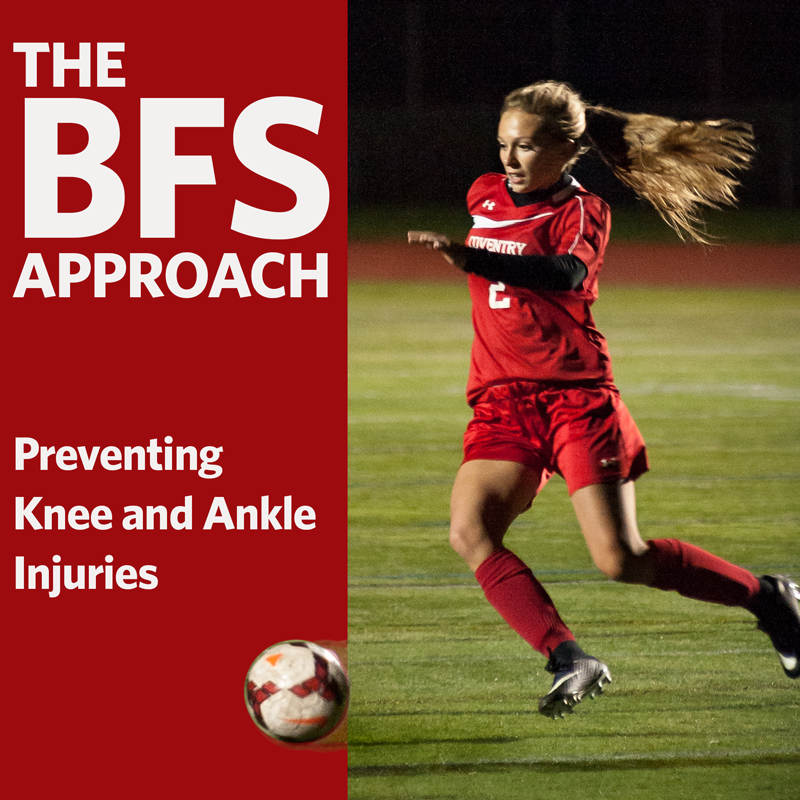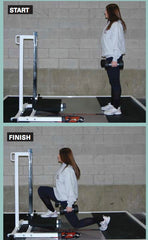The BFS Approach - Preventing Knee and Ankle Injuries

By Kim Goss.
The big stories coming out of the NBA Finals were not just that a team from Canada won, but that lower extremity injuries plagued the returning champions. What’s especially intriguing is the sports media’s perspective on why these injuries occurred.
The prevailing views by the sportswriters and broadcasters, many who played the sport at the highest level, was that an injury to one body part cannot contribute to an injury to another. Thus, Klay Thompson’s ACL tear had nothing to do with his recent hamstring injury, Kevin Durant’s calf pull didn’t make him susceptible to an Achilles rupture, and DeMarcus Cousin’s previous Achilles’ tear didn’t increase his risk of pulling his quadriceps. It was all just coincidence…or was it?
 Powerlifting squats are a great overall strength builder, but they do not work the legs through a full range of motion. Shown is Marv Phillips, a former world record holder in the squat. During an accident as a child, Phillips’s right arm was torn from his body, but doctors were able to sew it back on with 287 internal and 167 external stitches. (Bruce Klemens photo)
Powerlifting squats are a great overall strength builder, but they do not work the legs through a full range of motion. Shown is Marv Phillips, a former world record holder in the squat. During an accident as a child, Phillips’s right arm was torn from his body, but doctors were able to sew it back on with 287 internal and 167 external stitches. (Bruce Klemens photo)
How can an athlete reduce their risk of ankle and knee injuries? To answer this question, consider that most lower extremity injuries that occur in sports, especially basketball and soccer, are non-contact. The athlete did a sudden stop or turn, placing the ankle or knee in a compromising position, and something gave. The issue here is not so much what is going on with the muscles, but connective tissues such as the tendons.
Here's what most people, including athletes and their coaches, don’t understand. Tendons are not rigid, steel-like bands that connect bones to muscles. Tendons are active tissues that can elongate and shorten, acting as biological springs that help muscles produce force – you might call this effect, “elastic strength.” Further, tendons do not fatigue or require oxygen, and as such are exceptionally efficient at producing movement. In fact, one determining factor of athletic talent is tendon length.
Athletes born with longer tendons have a distinct advantage, especially when it comes running and jumping. As an analogy, consider that red kangaroos possess especially long tendons that can store up to 10 times more energy than their muscles, making them capable of moving long distances with little fatigue. In contrast, the advantage of a short tendon is that it creates a fuller muscle belly, so if your sport is bodybuilding and you have short tendons, you have a distinct advantage when it comes to developing budging biceps and calves that look like cows.
Because tendons can absorb, store, and release energy, it follows that an athlete needs to avoid taking actions that affect the elastic qualities of these tissues. One such action is the inappropriate use of athletic tape. Whereas some applications of athletic tape are necessary, consider that the downside of tape (and other forms of bracing) is that it can interfere with the tendon’s ability to function. Further, if you stiffen up a joint, the stress has to go somewhere. Thus, if you tape a calf muscle, you place more stress on the Achilles tendon; if you tape an Achilles tendon, you put more stress on the calf.
 The lunge performed to a step is an excellent exercise to work the legs through a full range of motion and keep your tendons healthy.
The lunge performed to a step is an excellent exercise to work the legs through a full range of motion and keep your tendons healthy.
How important is ankle mobility to injury prevention? One study of 10,393 Australian basketball players found that the “players who did not stretch before the game were 2.6 times more likely to injure an ankle than players who did.” Let’s look at another example.
Many athletes believe that tendons are fragile and that they should wear high-top tennis shoes for added support – however, there is no research to support the idea that high-top tennis shoes reduce the risk of any injury. Further, in the sport of weightlifting (snatch and clean and jerk), the athletes wear low-top shoes. And although male athletes have lifted triple bodyweight overhead and women have lifted double, ankle and knee injuries are rare.
 For over four decades, BFS has recommended performing squats to at least parallel to develop strong and healthy knees. Shown is Yurik Vardanyan, a Russian weightlifter who broke 41 world records and won gold in the 1980 Olympics. (Bruce Klemens photo)
For over four decades, BFS has recommended performing squats to at least parallel to develop strong and healthy knees. Shown is Yurik Vardanyan, a Russian weightlifter who broke 41 world records and won gold in the 1980 Olympics. (Bruce Klemens photo)
Since the 70s, BFS has promoted squats performed so that the top of the thighs are at least parallel to the floor (as with those with large legs, what may seem like just a parallel position is actually a full squat). This will ensure that the tendons maintain optimal flexibility.
Defending our position was a challenge, as many medical and fitness experts said that squats, especially when the knees extended in front of the toes, could cause knee instability and place high shearing forces on the knee that try to pry the joint apart. However, the preponderance of credible research in the last half-century on squats showed that squats not only do not cause joint laxity but improve joint stability.
As for this shearing forces concern, there is an inverse relationship between compressive and shearing forces. Squatting lower increases the compressive forces, thus reducing the shearing forces. One of the foremost experts on squats is Dr. Arron Horschig. A former competitive weightlifter, Horshcig has a doctorate in physical therapy and is the author of the book, “The Squat Bible.” Horschig says that during the squat, the highest stress on the ACL is during the first four inches of knee bend. Thus, if you want to keep your knees healthy, avoid overloading the knee ligaments and lower back with heavy quarter squats; instead, perform squats with relatively lighter weights but through a full range of motion.
As a final argument for allowing the knees to extend in front of the toes during squats, consider that it is not possible to walk, much less run, without the back knee extending in front of the toes.
The takeaway is that working the legs through a full range of motion with core exercises such as full squats and lunges, and even adding some calf raises and calf stretches to your works, is key to preventing ankle and knee injuries. It’s a simple concept that BFS has been promoting since we opened for business in the 70s, but if it works, it works!

 Powerlifting squats are a great overall strength builder, but they do not work the legs through a full range of motion. Shown is Marv Phillips, a former world record holder in the squat. During an accident as a child, Phillips’s right arm was torn from his body, but doctors were able to sew it back on with 287 internal and 167 external stitches. (Bruce Klemens photo)
Powerlifting squats are a great overall strength builder, but they do not work the legs through a full range of motion. Shown is Marv Phillips, a former world record holder in the squat. During an accident as a child, Phillips’s right arm was torn from his body, but doctors were able to sew it back on with 287 internal and 167 external stitches. (Bruce Klemens photo)  The lunge performed to a step is an excellent exercise to work the legs through a full range of motion and keep your tendons healthy.
The lunge performed to a step is an excellent exercise to work the legs through a full range of motion and keep your tendons healthy.  For over four decades, BFS has recommended performing squats to at least parallel to develop strong and healthy knees. Shown is Yurik Vardanyan, a Russian weightlifter who broke 41 world records and won gold in the 1980 Olympics. (Bruce Klemens photo)
For over four decades, BFS has recommended performing squats to at least parallel to develop strong and healthy knees. Shown is Yurik Vardanyan, a Russian weightlifter who broke 41 world records and won gold in the 1980 Olympics. (Bruce Klemens photo)